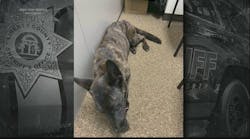Statistics show that children who grow up without a father are more likely to perform poorly in school, suffer behavioral issues, succumb to drug addiction and end up serving time in jail or prison. Children who grow up with a father have far less chances of suffering these problems, and are also more likely to be social and have higher self-esteem. What these facts ignore, however, is the effects of a father who is present in the home, but is abusive. Having an abusive father who regularly victimizes his spouse and children can be as devastating, if not more, than having no fatherly influence at all. In the world of criminal justice, we know that oftentimes people who are prolonged victims of abuse, often become abusers themselves. The generation that suffers family violence is faced with a difficult choice: continue the abuse, or break the cycle and try to undo the damage that’s already been done.
This article appeared in the July issue of OFFICER Magazine. Click Here to view the digital edition. Click Here to subscribe to OFFICER Magazine.
Cincinnati, Ohio, March 10, 1961, 29-year-old Cincinnati Police Patrolman Donald Martin began a special patrol in the city’s downtown area. After five years of police work, Patrolman Martin and his wife decided it was time for them to become parents. The couple made the decision to adopt a child and recently received word from a local orphanage that a baby would be available for them to adopt soon. With the new addition to the family, the Martins would need a family vehicle. Donald received permission from his sergeant to conduct a foot patrol of the Downtown Lincoln Mercury car dealership. His presence at the dealership would deter criminals, plus give him the opportunity to scope out a new ride. A win-win, until it wasn’t.Donald Martin got his start with the Cincinnati Police Department in 1956 after serving in the U.S. Army from 1948 to 1952. Martin fought in the Korean War, earning an honorable discharge, a Combat Medic Badge, and the Korean Service Medal. Since joining the police force, Martin’s accolades kept growing. He received several commendations in his tenure, including from the Cincinnati police chief himself, as well as very high scores on his performance evaluations. He was well liked and received praise from the commander of each district he had been assigned. Accomplished and experienced, Patrolman Martin had no qualms about handling calls on his beat solo. Unfortunately, on the night of March 10, Donald Martin’s capabilities were no match for the suspects he was about to encounter.
Around 3 a.m., Martin observed a car in the dealership parking lot with its hood open, and two men in front of it. Martin approached the vehicle and found the two men were attempting to steal the car’s battery. A fight began as Martin made his presence known, resulting in his uniform shirt being torn, and his .38 revolver being taken by one of the men. The patrolman was shot in the chest with his own weapon, and turned to retreat to his patrol car to radio for backup. As he attempted to get away from his attacker, he was shot twice more in the back. By now, the shooting had drawn the attention of a group of young men who were driving by just in time to see Donald Martin collapsed on the ground and be shot in the back for a third time. The men turned their car around to see if there was anything they could do to help the injured patrolman, but the shooter fired the revolver’s fifth round in their direction. They fled for their safety and flagged down another police car nearby. Before the backup officer could make it to the car lot, the shooter discharged the revolver’s sixth round into the back of Donald Martin’s head, and fled the area, as did the other thief.
Units from Cincinnati Police Department flooded the area and searched for Martin’s killer, to no avail. The crime scene was combed for clues, including a white button ripped from the shooter’s shirt during the initial scuffle. Eventually Martin’s revolver was found in a nearby trash can, as well as a gray jacket and a flannel shirt, which was missing a white button. This lead meant the only thing standing between detectives and the killer was finding who the owner of the shirt was. Unfortunately, the answer to this question would not come soon enough.
Every lead was followed and suspects were eliminated. Public tips poured in, but nothing panned out. Flyers asking for information about the shirt and jacket were posted all around Cincinnati, but no one was able to match them to their owner. In 1965, Donald Martin’s murder was declared a cold case. The prime suspect at the time the case went cold was a career criminal named Frank Murph. Murph had disarmed a police officer previously after shoplifting from a grocery store. He was arrested and served nine months in jail. In an unfortunate breakdown in communication, Murph’s name was cleared shortly after the Martin investigation began. Homicide Lieutenant Charles Martin learned Murph was in jail at the time of the patrolman’s slaying. The lieutenant documented this in his notes, however the information was not widely shared, leaving many in the department and the public to believe Murph was the killer, especially after he was shot and killed by police in Indiana in 1965 after disarming yet another officer after a robbery attempt. Lieutenant Charles Martin passed away unexpectedly in 1962, and his notes ended up buried in the case file.
Also in 1962, Jerry Schimpf, a juvenile detective, arrested a rape suspect at a diner in downtown Cincinnati. In an attempt to gain leniency, the suspect’s brother offered up the name of a cop killer. That name was Walter Baker Walls. Schimpf and Homicide Detective William Stagenhorst, located Walls in the Ohio State Penitentiary, incarcerated after a burglary conviction. His appearance matched the description given by the men who witnessed the shooting, the shirt and jacket found in the dumpster fit him perfectly, and he failed a lie detector test. There wasn’t enough physical evidence at the time, however, to prove Walls was the killer. He denied any involvement in Martin’s murder and forensic techniques of the time had not produced any fingerprints which could be matched to Walls. Schimpf and Stagenhorst both left the department within a few years and nothing new was discovered about Walter Walls. The belief that Frank Murph was Martins’ killer persisted, and the Walls theory went by the wayside.
In 2005, homicide detectives Kurt Ballman and Jeff Schare reopened Martin’s file in hopes they could use modern investigative techniques to officially close it. They found the notes that eliminated Frank Murph as a suspect, and realized the case deserved a full review. They thoroughly examined every report and piece of evidence and learned there were some leads it would behoove them to reexamine. With Murph off the list, the first move was to determine if Walter Walls could be eliminated too. Looking back at Walls’ life after he was investigated by Schimpf and Stagenhorst, he apparently wasn’t rehabilitated after his release from prison in 1963. In 1969, Wall’s wife, Ann Walls, was shot to death by Brenda Anders, Walter’s girlfriend. Complicit in her murder, he avoided charges by testifying against Anders, landing her an eight-year prison sentence. Walter Walls had passed away in 2002, making it impossible to question him further about Donald Martin’s murder. His family members, however, were still alive, and willing to talk.
As is often the case in a household run by a criminal, Walter Walls’ family members were victims of his violence as well. When Walls’ name first came up in the investigation in 1962, none of his family members were willing to provide any information, evidently out of fear for what Walter would do to them if they cooperated with police. Now that he was gone, there was nothing to fear, and detectives Schare and Ballman immediately found the answers thy were looking for.
Ballman and Schare knocked at the door of Anna Dove, daughter of Walter Walls. When she answered and learned she was speaking with Cincinnati Police Department detectives, she stated “This isn’t about my dad killing a cop, is it?” As a matter of fact, that is exactly what this visit was about. Dove explained that she witnessed her mother’s murder at the hands of Brenda Anders, and, as if that wasn’t terrible enough, her father put a gun to her head and told her he would kill her the same way he “killed that cop” if she said anything. Several more family members were interviewed and explained that Walter Walls would brag from time to time about killing a cop. Brenda Anders, no longer in prison for the murder of Ann Walls, explained she was manipulated and brainwashed by Walter when he convinced her to kill his wife. She also said Walter told her he had killed a cop, as well as a man named “Cadillac Charlie,” who was a witness to the officer’s murder.
Through these interviews with people close to Walter, and the investigative work 40 years prior, Ballman and Schare were finally able to put together a clear image of what happened on the night of Donald Martin’s final patrol. Walter Walls and his brother Jesse, who has also since passed away, were out at a bar when they called their friend “Cadillac” Charles Jillson for a ride. Rather than turn in for the evening, Walter decided he wanted to steal a battery from a car so he could get his own vehicle up and running again. The team of crooks settled on a car on the Downtown Lincoln Mercury lot. Jillson waited in his car, in case a speedy getaway was necessary, and the Walls brothers began removing the battery. Patrolman Martin approached the thieves and Walter attacked. Possibly with Jesse’s assistance, Walter disarmed Martin and began firing. Jillson, evidently didn’t want any part of the murder, and drove away, abandoning Walter and Jesse. Walter later bragged to another one of his brothers he caught up with “Cadillac Charlie” and left him in a shallow grave. Walter and Jesse fled the scene of the shooting, and Walter dumped the gun and his clothes in a nearby trash can.
These statements provided enough answers to the decades-old questions surrounding Martin’s murder that the District Attorney’s Office announced if Walter Walls was still alive, there was enough evidence to charge him with murder and likely obtain a guilty verdict. The case of Donald Martin’s Murder was officially closed, solved by two detectives who weren’t even alive when it happened. Walter Walls bragged for decades that he was the man who killed Martin, but evaded charges because of his tyrannical, abusive ways. No one would dare speak out against him, for fear of what he would do to them. He left several bodies in his wake, including that of his own wife. His family decided to break this cycle and no longer keep his secrets, but only once they knew he was no longer able to harm them. Unfortunately, the family of Donald Martin did not get the answers they sought, until the family of Walter Walls was safe to provide them. Thanks to the family of his killer, Donald Martin’s ultimate sacrifice is no longer a cold case.
This article appeared in the July issue of OFFICER Magazine.




